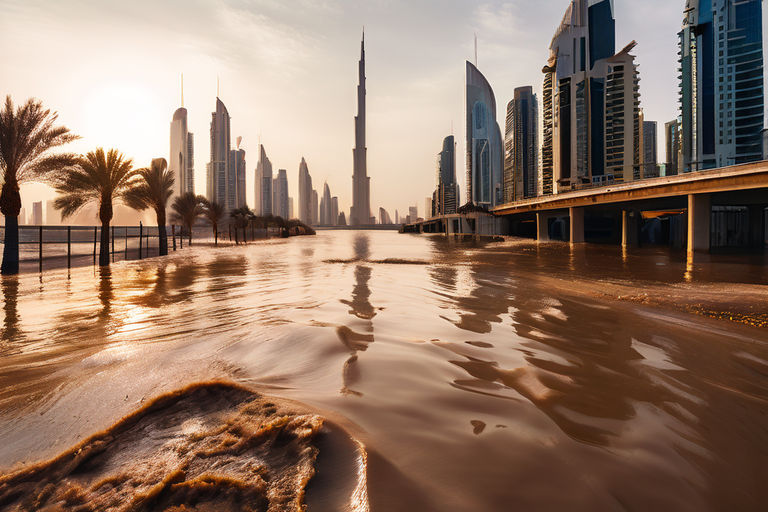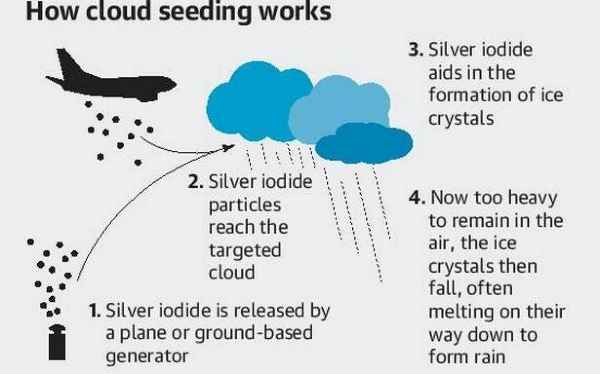
A year’s worth of rain has plunged normally dry Dubai underwater turning roads into rivers and flooding homes and businesses, disrupting airport operations and causing multiple flights to be cancelled. Expert meteorologists are calling this a “once-in-a-lifetime rainstorm”. So how did this happen is cloud-seeding to blame for this disaster?
But first, let’s back up a little and find out more about cloud-seeding.
In this article
What is cloud seeding and how does it work?

Cloud-seeding is a process that aims to enhance precipitation by introducing small particles, such as silver iodide, into clouds. The cloud-seeding process involves introducing seeding agents at the lower part of clouds with favorable updrafts, enhancing microphysical processes such as condensation and coalescence, and leading to the enlargement of droplet sizes, making them heavier. These particles act as nuclei for water vapor to condense around, leading to the formation of raindrops. By strategically deploying aircraft to disperse these particles, scientists can potentially influence the weather patterns and increase rainfall in targeted areas. Cloud-seeding is typically employed when natural conditions, such as wind, moisture, and dust, are insufficient to trigger rainfall.
While cloud-seeding may seem like a modern invention, it has actually been around for several decades. In recent years, the United Arab Emirates (UAE) has embraced cloud-seeding as a means to combat water shortages. The UAE has successfully utilized this technique to augment its water resources and support its agricultural and ecological needs.
The UAE cloud-seeding programme, also known as the UAE Research Program for Rain Enhancement Science, first started in the late 1990’s and reportedly produces around 15% additional rainfall each year alone. It is a costly process that involves the use of drones equipped with concentrated lasers to target clouds with electrical discharges in order to trigger rainfall.
The cost of cloud seeding missions in the UAE is up to $8000 per flight hour, with 390 flights conducted in 2020. When considering the determined range of harvestable rainfall volumes from seeding (84 MCM to 419 MCM), the unit cost of harvestable seeded rainfall can be estimated between $0.01 to $0.04 per m3, which is up to 30 times less than the cost of desalinated water production.
Abnormally huge Dubai rainfall
Up to 259.5mm (10.2in) of rain fell within 24 hours on the usually arid country of the UAE on Tuesday 16 April 2024, the most since records began 75 years ago. The state-run WAM news agency called the rains on Tuesday “a historic weather event” that surpassed “anything documented since the start of data collection in 1949”.
The rainfall, which flooded streets, uprooted palm trees and shattered building facades, flights were canceled, traffic came to a halt and schools closed.
A timelapse of the storm that caused flooding in Dubai. pic.twitter.com/y5lScQIj6I
— Champagne Joshi (@JoshWalkos) April 18, 2024
The rain fell so heavily and so quickly that some motorists were forced to abandon their vehicles as the floodwater rose and roads turned into rivers.
🚨🇦🇪 Dubai Apocalypse
— Concerned Citizen (@BGatesIsaPyscho) April 17, 2024
Insane compilation of recent weather event in Dubai – it’s like a movie scene ‼️
The Tornado at 39 seconds in I’m sure is CGI? Other than that the rest is real.
Surely we should be talking about those Weather Manipulation Control rooms right….? pic.twitter.com/HXCDwPnXzr
AFP reported that power outages were reported around Dubai, which was dotted with flooded areas and submerged and abandoned cars.
One road tunnel near the airport was flooded to its roof, and some residential villas were thigh-deep in water.
At least one person was killed in the flooding. A 70-year-old man who was swept away in his car in Ras Al-Khaimah, one of the country’s seven emirates, according to police.
Timelapse of the incoming storm that’s caused chaos is Dubai ‼️ pic.twitter.com/vPw4S1cYyt
— Concerned Citizen (@BGatesIsaPyscho) April 17, 2024
Similar scenes were visible around the Gulf state, including in Sharjah, neighbouring Dubai, where residents waded through main streets and paddled around on makeshift boats.
🚨🇦🇪 UAE Admits to assisting Israel in shooting down Iran drones.
— Concerned Citizen (@BGatesIsaPyscho) April 17, 2024
2 days later Dubai, UAE is under water.
Coincidence? pic.twitter.com/v8E37DMT2p
Like the rest of the United Arab Emirates, Dubai has a hot and dry climate and as such, rainfall is infrequent and in many areas there is limited infrastructure such as drainage to handle extreme events.
This historic flooding fuelling speculation on social media that cloud-seeding is to blame – but experts have said this is not to blame for the downpours.
Regional weather storm
The weather conditions were associated with a larger storm system traversing the Arabian Peninsula and moving across the Gulf of Oman. This same system is also bringing unusually wet weather to nearby Oman and southeastern Iran.
In Oman, at least 18 were killed in flash floods triggered by heavy rain, the country’s National Committee for Emergency Management said.
Drone Footage after Rain in #Dubai#DubaiFlooding #dubairain pic.twitter.com/bFIMQrG5ja
— Fighter_4_Humanity (@Fighter_4_Human) April 18, 2024
Instead, meteorologists have attributed the storm to the emergence of a mesoscale convective system (MCS), which occurs when storms become interconnected around a weather front.
Professor Suzanne Gray, Professor of Meteorology at the University of Reading, said: “Satellite imagery suggests the flooding and rainstorms Dubai were caused by something called a mesoscale convective system. Mesoscale convective systems are what we get when lots of individual thunderstorms amalgamate to form a single large high-level cloud shield, typically hundreds of kilometres across, together with a large region of heavy rainfall.
“They are not rare events for the Middle East. A recent published study analysed 95 events that occurred over the southern Arabian Peninsula from 2000-2020 and found that they most often occur in March and April. A previous event in March 2016 caused more than 240mm of rain in Dubai in just a few hours, similar to the totals being reported for this event. This study also found that these MCSs have increased in longevity over the UAE over this 21-year period. MCSs do occur in the UK, but typically just a couple of times a year during the warmer months when they are usually associated with a plume of warm air coming from Spain.”
Separating fact from fiction
In the wake of extreme weather events, it is not uncommon for social media to buzz with speculation and misinformation. Following recent floods, some individuals hastily attributed the severe weather solely to cloud-seeding operations in the UAE days before the storm. However, it is crucial to distinguish between correlation and causation.
Reports from Bloomberg indicated that cloud-seeding planes were deployed on certain days, but not on the day when the flooding occurred. The National Center of Meteorology (NCM) in the UAE has denied they carried out any cloud-seeding operations before the heavy storms that caused flooding in Dubai.
While the exact timing of cloud-seeding operations remains unverified, experts assert that any potential impact on the storm would have been minimal. Focusing solely on cloud-seeding as the cause of the extreme weather can be misleading.
Dr. Otto, a renowned expert in the field, emphasizes that even if cloud-seeding did contribute to increased rainfall, it is essential to consider the broader context of climate change. The atmosphere is already experiencing higher moisture levels, which can naturally lead to cloud formation and precipitation. Cloud-seeding, therefore, becomes just one piece of the puzzle in a complex weather system.
It is important to note that cloud-seeding alone cannot account for the widespread impacts of severe weather events. Meteorologists, such as Matt Taylor from BBC Weather, emphasize that computer models, which do not consider cloud-seeding effects, had already predicted substantial rainfall before the event. The severe flooding experienced across the region extended far beyond the scope of cloud-seeding operations.
Cloud-seeding missions in the UAE are overseen by the National Center of Meteorology (NCM), a government entity dedicated to meteorological research and forecasting.
Citations:
Dubai floods: Exact cause of ‘once in a generation’ rainfall – links to cloud seeding fact-checked, 17 April 2024
HOW IS DUBAI CREATING ARTIFICIAL RAIN? November 2023
UAE To Carry Out Hundreds of Cloud-seeding Missions In 2024 To Tackle Water Scarcity, January 2024
Rethinking water security in a warming climate: rainfall enhancement as an innovative augmentation technique, October 2023
UAE government says cloud seeding didn’t take place before Dubai floods, 17 April 2024







